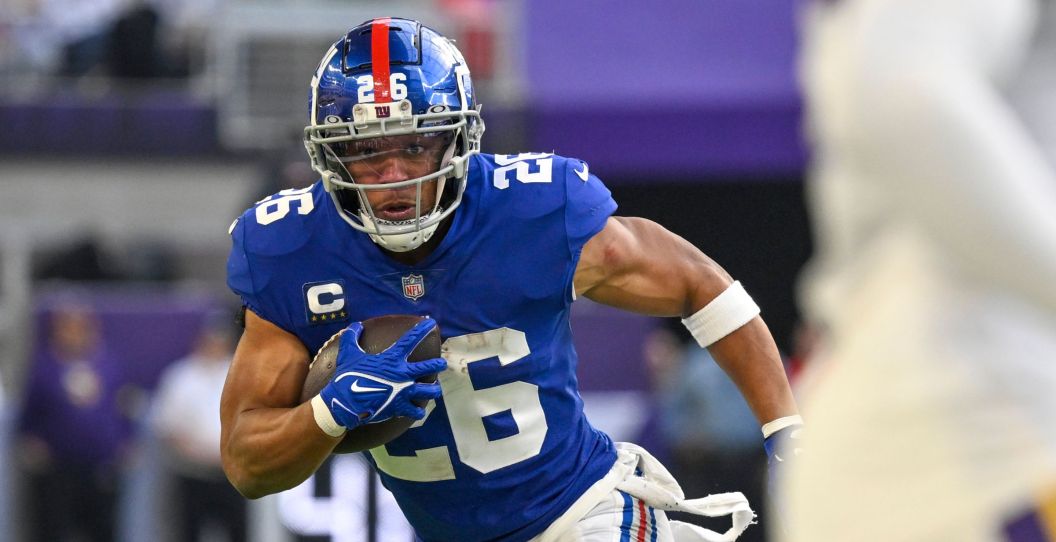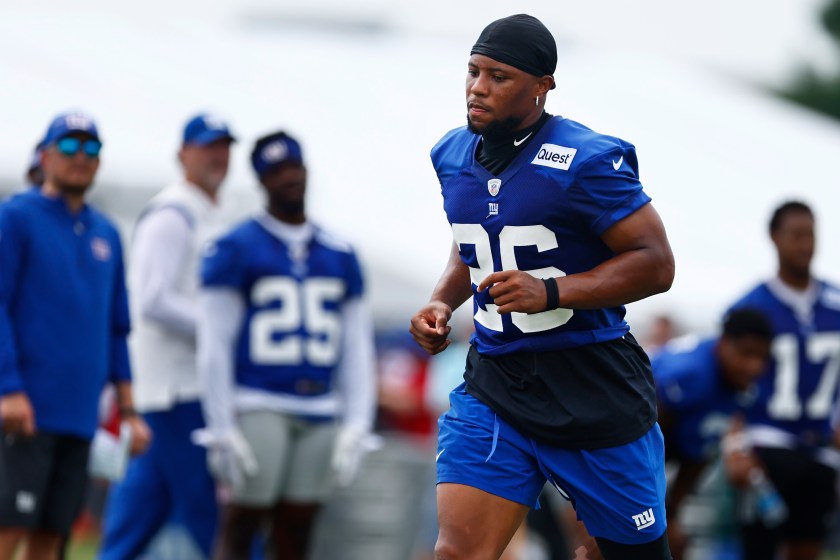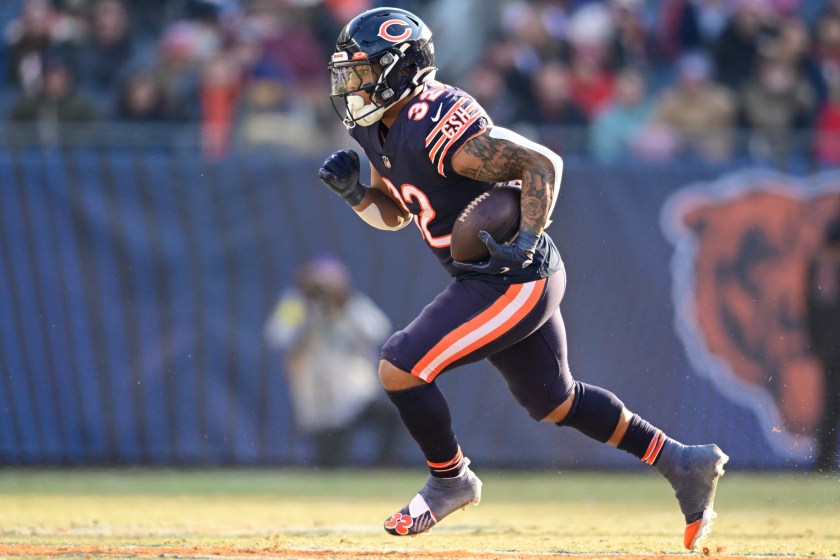Money isn't coming to NFL running backs the way it used to.
The gap between the productivity of NFL running backs and their expected contract values continues to grow. A series of trend changes in football — along with decisions made by the National Football League Players Association in recent collective bargaining agreements — have left running backs with less leverage than ever before. The issue has veteran running backs scrambling and "heading to the group chat" as the most talented veteran tailbacks try to figure out how to regain some prosperity for the position.
One of the first dominoes that has led to this fall from economic grace was the introduction of the franchise tag. A franchise tag allows a team to keep a player for an additional season after his contract expires, but it must pay that player a salary consistent with the NFL's top performers at that player's position.
When the franchise tag was first agreed upon in 1993 as part of the NFL collective bargaining agreement, the state of the NFL was different. Bruising tailbacks such as Emmitt Smith, Jerome Bettis and Thurman Thomas were focal points of dominant NFL offenses. Even dynamic rushers such as Barry Sanders were making more than 300 carries a year, and a premiere tailback was nearly a requirement for success in a run-first league.
It was this incredibly high valuation of running backs that — just a few years before this collective bargaining agreement — convinced the Minnesota Vikings to mortgage their future draft capital to trade for Herschel Walker from the Cowboys. A similar move would happen later in the '90s, with Mike Ditka trading the Saints' entire draft class to select running back Ricky Williams. A game-changing rusher was absolutely coveted.
However, much like the classic "back-to-the-basket" NBA big man who was dominating during the same period, trends within the game began to move away from hitching your wagon to a dominant back. Gone are the days when the NFL offense was about handing the ball off for "three yards and a cloud of dust" each play.
But in 1993, the idea of the franchise tag seemed reasonable for NFL running backs, who were being paid some of the league's top salaries compared with other position groups. With teams committing to the strongest players at the position — often for nearly the entire length of their careers — it felt like a reasonable way to offer roster security for teams and financial security for players.
When we zoom ahead to 2023, we see the NFL has morphed into a pass-first league, predicated on scheming ways to get athletes into space and designing rosters with quick-strike capabilities from anywhere on the field. The "cloud of dust" is gone and, along with it, the salary expenditure on running backs.
The NFL's Running Back Dilemma is a Vicious Cycle
In 2023, the franchise tag compensation amount for running backs is actually the second lowest for any position in the league, ahead of only punters and kickers. It's a comparably low total that shows teams around the league are unwilling to commit to running backs on second and third contracts.
This is especially true after they have made a multitude of carries, because of durability concerns and the idea that younger and cheaper replacements at tailback are simply a better practical decision. It also means that offering a running back a franchise tag becomes a cheaper option for a team and doesn't require any level of commitment should the player get hurt or become less productive. It's why the only three players who will enter the 2023 preseason with franchise tags — Saquon Barkley, Josh Jacobs and Tony Pollard — are all running backs. It's a development that sparked a Zoom call among some of the best backs in the league to discuss the lack of leverage for NFL ball carriers.
Some positions, such as tight end, have begun to create offseason workout camps for the best and brightest at their position in the league. The idea behind these is that the improvement of all tight ends is more valuable to increasing salaries for the position as a whole rather than creating a gap between the best tight ends and their peers.
The situation for running backs isn't that simple, however. They face the idea that they are replaceable, as the gap closes between the production of some of the best at the position and those likely to replace them at a cheaper cost. It's why some of the most productive running backs in the league from the last several seasons — such as Dalvin Cook, Kareem Hunt, Leonard Fournette and Ezekiel Elliott — remain free agents.
Cleveland's Nick Chubb was quoted in an ESPN article saying, "We're kind of handcuffed with the situation. We're the only position that our production hurts us the most. If we go out there and run 2,000 yards with so many carries, the next year they're going to say, you're probably worn down. It's tough. ... It hurts us at the end of the day."
This idea — that the role is exploited by teams looking to maximize the value of talented running backs when they are young but refusing to commit to them at later stages in their career — can also be linked to an NFL Players Association concession as part of another collective bargaining agreement.
The "rookie wage scale" was introduced as part of the 2011 agreement. It was an agreement between the owners and the players union that made a lot of sense at the time for both sides, and in many ways it still does. Owners were frustrated at the escalating cost of committing to unproven rookies and top-level draft picks (never forget Jamarcus Russell's contract for the Raiders), while veterans were upset that teams' cap limitations from these rookie contracts were causing them to receive less money after their rookie deals once they had proven their worth in the league.
For most positions, this rookie wage scale seems to be working out with a reasonable balance for the players and the owners — but not for running backs. The agreement seems to greatly disfavor the talented veteran running backs in the NFL.
The Bears Are a Perfect Example of The Problem
Let's look at the Chicago Bears as an example. They drafted David Montgomery in the third round of the 2019 draft and signed him to a rookie deal for four years at just over $1 million per season.
After a productive four years in Chicago, Montgomery signed a three-year-deal with the Detroit Lions that earns him roughly $6 million per season. The Bears have a ton of cap space, and Montgomery is only 26 years old and continues to show improvement, so one would think Chicago would have been interested in retaining him. Instead, the Bears opted to promote backup Khalil Herbert. Herbert still has two years left on his rookie deal that pays him less than $1 million per season. For a relatively small drop-off in talent and production, the Bears are saving about $5 million in salary cap space each season by going with the slightly younger Herbert, who is still on his rookie deal.
What about the Lions, the team that decided to pay Montgomery? They can justify the move because they chose to trade running back D'Andre Swift before they had to pay him his second contract. Trading Swift while he was in the last year of his rookie deal netted Detroit a fourth-round pick. That draft choice will become a player they will have four years of contract control over at a much cheaper salary.
In addition, the Lions selected rookie running back Jahmyr Gibbs in the first round — who, thanks to the rookie pay scale, Detroit will have the option to have contractual control over for up to five seasons. The first four years of Gibbs' contract will cost the Lions only slightly more than $4 million per year — cheaper than Montgomery, who already has 900 career carries on his legs. And if Gibbs performs well, he may force the Lions to decide to cut Montgomery before the final non-guaranteed year of his deal.
All of this is to say that teams are winning by saving money against the cap when they invest in running backs on their rookie deals. Those runners, if they play well, will actually reduce the value that a coveted veteran running back has on the open market. The great irony is that, someday in the near future, they will become that veteran runner judged against those same deals they undercut.
So this all leaves the league's best runners scratching their heads. They know they can't be loyal to teams and owners that seem ready to move on from them at a moment's notice. They know that they need to quickly play themselves into a large contract before they hit their late 20s. But they also know that by performing well and taking on a ton of touches, they actually reduce their future value in a league where longevity at the position is becoming difficult to sustain.
Consider Cam Akers, Isiah Pacheco, Leonard Fournette, Damien Williams and Sony Michel. Those were the leading rushers of the last five Super Bowl winners.
Three of those players were on rookie deals.
Williams was playing for a modest $1.6 million for the Chiefs in 2019, and that championship game would be his final contest for Kansas City. Despite more than 1,600 scrimmage yards in his final season in Jacksonville, the Jaguars opted not to pick up Fournette's fifth-year option on his rookie deal.
Fournette opted to sign with Tampa Bay on just a one-year, $2 million contract ahead of that 2020 Super Bowl run. He was cut as a cap casualty from Tampa Bay this offseason and is currently a free agent.
What does this tell us? Teams are winning the Super Bowl with rookie runners and cheap veteran replacements, which means they likely won't stop trying to build their roster using this strategy. And many of the top runners in the NFL could fall victim to their own successes when it comes to free agency.



